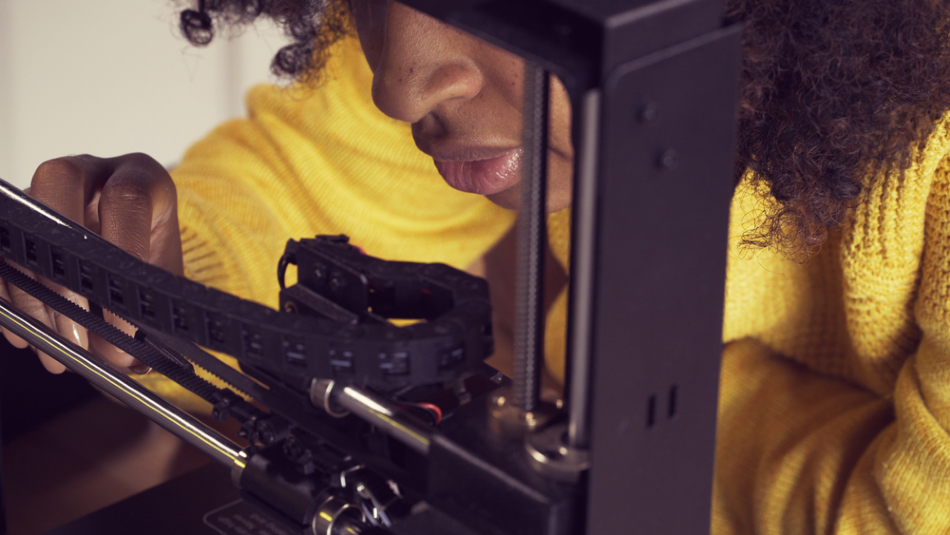
Image Credit: Made360/Shutterstock.com
Scientists are now looking to the fourth dimension to create a new generation of printed smart materials capable of changing their shape.
3D Printing vs 4D Printing
Three-dimensional printing, also known as additive manufacturing, takes a digital blueprint and turns it into a physical object using computer-aided design (CAD).
A repeating 2D structure is built up, layer by layer, from bottom to top until a 3D construction is complete. The finished object is characterized by its rigidity and inability to change shape, much like any typical metal or plastic part.
The process of 4D printing is essentially the same - it utilizes the same 3D printers, and the computer runs the same program to deposit material in successive layers until a 3D structure is formed.
Click here to find out more about 3D printing technologies.
However, 4D printing adds a new dimension, where the structure can change its shape over time. It requires unique materials and customized designs to be built into the program to prompt the 3D print to change shape when triggered by a specific stimulus, such as heat, water or light.
This programmable ingredient – a hydrogel or shape memory polymer – is capable of altering its physical shape or thermomechanical properties in a programmable way based on user input or autonomous sensing.
Hydrogels can absorb large amounts of water and can be programmed to shrink or expand with changes in the external environment. Shape memory polymers can return to their original shape from a deformed one when a stimulus is applied.
While 3D printing contains the instructions to print layers of material successively, 4D printing adds a precise geometric code to the process based on the angles and dimensions of the desired shape. It gives the shape memory and instructions on how to move or adapt under certain environmental conditions.
Research into 4D-Printed Forms
There are many institutions and companies currently researching 4D-printed forms and their possible applications.
MIT’s Self-assembly Lab is home to a project combining technology and design to invent self-assembly and programmable material technologies to reimagine construction, manufacturing, product assembly, and performance.
One development sees a flat-printed structure slowly fold into another conformation when placed in hot water. This could allow much larger structures to be printed on a smaller scale to expand or unfold at a later stage.
The lab has been researching programmable wood, which could be scaled up for self-assembly furniture. Imagine a 4D-printed flat board that curls up into a chair by adding water or light.
Programmable Wood
Video Credit: Self-Assembly Lab, MIT/Vimeo
The Lab’s founder, Skylar Tibbits, believes the technology has great potential in many areas, including the fashion industry. He envisages trainers that change their fit on your feet depending on what you are doing, and clothing that can alter its composition in response to the weather.
However, it is more likely that you will cross paths with 4D printing in the form of medical implants or mechanical systems that change configuration in different environmental conditions.
Researchers at the University of Wollongong in Australia have developed a 4D-printed water valve that closes when exposed to hot water, and opens again once the temperature has cooled. It uses a hydrogel ink that responds quickly under heat.
4D printing could be used in biotechnology or in medicine. For example, 4D-printed stents could be placed into blood vessels and expand when they reach the right area, adding extra support. They might also be used in drug capsules that change shape to release the medicine once reaching their destination.
Read more: Building a Rocket in 60 Days: The Future of 3D Printing in Aerospace
Researchers at The George Washington University have developed a type of 4D-printable, photo-curable liquid resin from a renewable soybean-oil epoxidized acrylate compound. This could be used as a scaffold for bone marrow stem cell growth.
Other medical applications might include self-reconfiguring proteins or self-folding proteins – another project from MIT’s Self-assembly Lab.
Additional uses include self-repairing pipes that alter their diameter in response to water demand and flow rate, and heal cracks or breaks in themselves. Such materials would be advantageous in extreme environments such as space, as the transformable shapes of 4D-printed materials would allow bridges and shelters to be built, or the possibility of self-repair when damaged by weather.
Architecture could also benefit, as adaptive facades or self-opening/closing roofs that are activated by the weather are also among future applications.
The Future of 4D Printing
4D printing technology is still very much in the early stages of research and development.
Currently, the only places likely to house 4D-printed forms are laboratories and prototyping facilities, as well as some architectural exhibitions and art installations.
The future looks promising and, as with 3D printing, the list of possible applications is huge. The use of such smart materials could revolutionize the world of materials as we know it.
References and Further Reading
Young, M. (2019) 4D Printing – All You Need to Know. [Online] All3DP. Available at: https://all3dp.com/1/4d-printing/ (Accessed 17th June 2020).
Sculpteo. 4D Printing: A technology coming from the future. [Online] Available at: https://www.sculpteo.com/en/3d-learning-hub/best-articles-about-3d-printing/4d-printing-technology/ (Accessed 17th June 2020).
Taylor-Smith, K. (2019) What is 4D Printing? [Online] AZoNano. Available at: https://www.azonano.com/article.aspx?ArticleID=5117 (Accessed 17th June 2020).
Ofek, A. What is the Difference Between 3D Printing and 4D Printing? [Online] 3DP Master. Available at: https://3dpmaster.com/what-is-the-difference-between-3d-printing-and-4d-printing/ (Accessed 17th June 2020).
Disclaimer: The views expressed here are those of the author expressed in their private capacity and do not necessarily represent the views of AZoM.com Limited T/A AZoNetwork the owner and operator of this website. This disclaimer forms part of the Terms and conditions of use of this website.